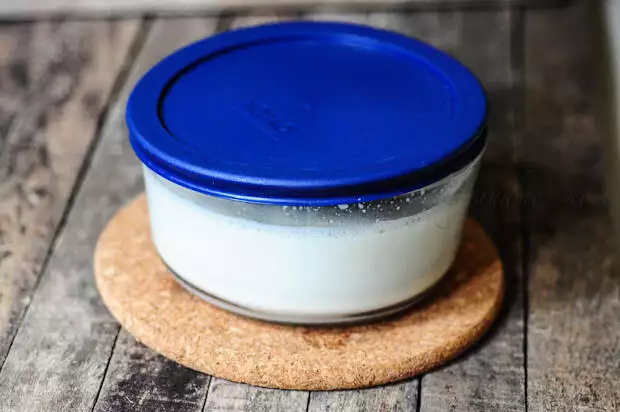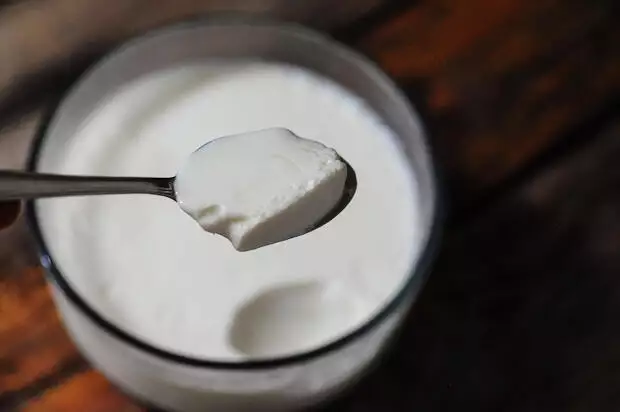I quickly realised I need to master the art of how to make curd at home because buying those Nestle curd cartons from the store was not working out very well for our wallets.

Also, there’s something special about homemade curd. Although you are not really doing anything special, it feels a bit magical to heat up some milk, add some curd in there, mix, set it aside, and magically have it harden up and taste awesome after a few hours. That’s really all there is to homemade curd or yogurt. Indian lassi like mango lassi or strawberry lassi drinkstaste way better when you use homemade yogurt to make them too.

However, there are a few things to keep in mind while making curd at home. I learnt most of it by trial and error and I finally feel ready to share it with you all.
Homemade Indian Curd Recipe
Preparation time: 6 hours
Makes 500 ml set curds
Ingredients for making curd:
500 ml of milk (see notes below)
1.5 tsp of curd
How to make Curd:
1. Bring the milk to boil and set aside to cool. The temperature to which it needs to cool is important. It should be warm – not lukewarm, not hot. A good test is to insert your (clean!) finger in the milk and see if you can hold it there for 10 seconds without needing to pull it out because it’s too hot or feeling too comfortable because it’s too cold.

2. Transfer the milk to the container you want to set the curds in.

3. Add the curds to the milk. Yes, to make curd you need curd as a starter. The bacteria in our starter then acts on the rest of the milk and turns it all to curd. How cool is that, eh?

4. Mix the curd and the milk well together. This step is important. The better they are mixed, the quicker and better the curd will set. Using a whisk is a great idea too.

5. Once mixed, keep loosely covered in a warm place. Once the milk has completely cooled down, you can close the lid tighter (even airtight) but this is not necessary.

6. After about 6-8 hours, tadaaa! 🙂

Although I have been making curd at home for more than 4 years now, I still feel great when I see a perfectly set batch of homemade curd.

One of my favourite “quick snack” as a kid was to eat freshly made dahi with some sugar.
Notes:
– The type of milk you use for making curd impacts the outcome largely. Amma buys directly from a local milkman so her curd turns sour in a matter of hours. She makes fresh curd every day.
– I use the UHT (ultra-heat treated) milk available in cartons in Singapore. I have tried pretty much every brand and find that the Fair Price full cream milk gives me the best results. You can see a picture of it in the ‘how to make paneer‘ post. Fresh milk works too but the more the fat content, the thicker your yogurt.
– The temperature and humidity of the place you live in plays a major part too. Since Singapore is warm through the year and quite humid, I can leave the curds to set pretty much anywhere and still turn up with great results. If you live in a cold place, I would recommend the oven light technique that we discussed in the idli batter recipe post. Just leave the curd to set in your oven with the light turned on for warmth.
– If your curd is stringy and gooey, that means the temperature of the milk was not right – either it was too hot or too cold. You will have to experiment a bit with this to get it right for the place you live in.
– If the curd hasn’t set even after 6-8 hours (or 10 hours!), it’s possible you used too little starter curd amount, the milk was not warm enough or the temperature is not warm enough.
– What type of vessel should you use to set curd? I am told stainless works out the best but have found out that it doesn’t matter that much. I use pyrex glass bowls and love the convenience. Having an airtight lid to close it once the milk has cooled down helps the setting process for curd.
– Try to use the starter curd at room temperature so it doesn’t bring down the temperature of the milk too much. This is not a make or break situation but no harm in being careful.
– To make curd without curd as a starter, try adding a couple of dry red chillies (with stalk if possible) into the heated milk. I haven’t tried this but a friend of mine said this works as did Sreelu who said it makes curd set faster and thicker in the US.
I think I’ve covered most of the things that could go wrong with making curd at home, but let me know if you have other questions.

Sometimes when I set curd, a wheyish liquid forms atop of the set curd. Though the curd comes perfect, may I know what could be the reason behind it?
Thats the Wonderful Post 🙂 with lot of notes !
I know it could be difficult for you..but putting your milk in a clay container (not baked much which should be porou), ll remove extra water forming out of the process, ll get you good result..i have seen women in Gujarat, selling super tight curd which dont overflow even after turning the bowl upside down..
wow, didn't know about that. if i need hung curd, i make that separately by hanging curd in a muslin cloth tied over the sink
Yes. Setting in kulhads(earthen cups used to serve tea) yields great results! We do that in Gujarat. 🙂
I think the best container to set curds is either ceramic or terracota/man chatti that we get in India. The porous nature of these materials make the curds set well.
Nice article with tempting pics. One question – will curd set properly in plastic containers? I use only steel dabbas for that.
I have added this question to the post now 🙂 I use a glass container actually. Although it's said that steel works best, I have found it doesn't make much of a difference compared to the other variables in making curd. Plastic would be my last option though.
A very aesthetic story there..beautiful pictorial Nags…
Very useful post, perfect
me to using te same way t set curd while making at home.. but during winters i like to use casseroles and tight lid the container… and da.. here you will get a thick and yummy curd in winters too.. 🙂 🙂
I have a funny situation. I boil the milk and let it cool to the right temp and then put it into two separate bowls and using the same measuring spoon add curd for setting. One bowl turns out with perfectly set curds while the other one becomes gooey. Any idea why this hsppens? We live in Penang and I guess the weather is almost the same as Singapore. So it has always become a gamble while setting the curds. Oh and buying those curd cartons is super expensive when you think of the simplicity iof doing it at home
hah! now that's a unique issue alright. i think the milk in the second bowl cools down a bit by the time you get to it? Not sure.
I know its wierd. Anycase I dont mind as the gooey curd gets used up for my Rava Idlies 🙂
Eating gooey curd does not feel right, i know… But what i do is make raita with it… Adding salt an other spices breaks down the gooeness and it looks like simple whisked curd…
Nice tips Nags. I use the same pyrex container with the blue lid to set curd everytime. I actually microwave it for a few minutes and the curd turns out perfect!